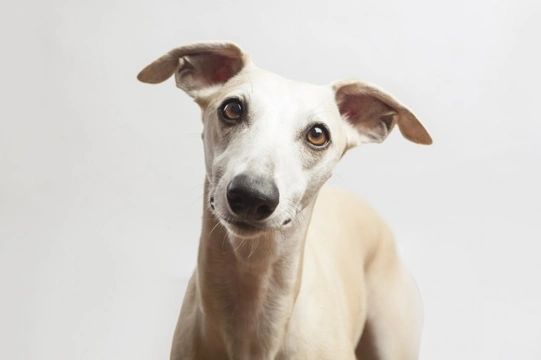
Do greyhounds need to be given a different anaesthetic to other dogs?
The greyhound is perhaps the best-known dog of the sighthound type, and whilst this breed used to be kept mainly for racing first and as a pet secondly, today the greyhound is a very popular pet with a huge number of positive traits that ensures their enduring appeal. Here you can find all greyhounds for sale.
This is a dog breed that tends to make friends everywhere they go, thanks to their calm, laid back natures, love of affection, high degree of loyalty, and kind temperament. They are also a somewhat misunderstood breed by those unfamiliar with them, who assume that their incredibly high running speeds equate to a high energy breed that is vastly challenging to exercise, but this is absolutely not the case!
The greyhound is commonly known amongst those familiar with the breed as “the world’s fastest couch potato” and this is a fantastic descriptive for a breed whose members tend to be in committed long term relationships with the sofa, and that can rival cats in terms of their laziness and tendency to sleep!
Whilst all greyhounds can and do need to run and will generally reach a flat-out top speed daily as part of their walks, they need much less exercise than most breeds of the same sort of size, and expend their energy quickly in those short bursts of high speed.
This is one of the complexities that make the greyhound breed something of an enigma, and many of their core traits surprise people just getting to know the breed for the first time!
Another key trait of greyhounds that most people unfamiliar with the breed – and some that are – don’t know is that anaesthetising a greyhound for a veterinary procedure like spay, neuter, or non-routine emergency surgeries needs to be handled with care, particularly the first time the dog has a general anaesthetic.
This is because many dogs of the breed are sensitive to or intolerant of anaesthesia, including some of the most commonly historically used veterinary anaesthetics – and that this can be life-threatening if not mitigated.
All greyhound owners should be aware of this, and have a basic understanding of the challenges, risks and considerations required when a greyhound needs a general anaesthetic, and should discuss all of this in depth with the vet administering it before signing off on the procedure.
This article will explain what greyhound owners need to know about general anaesthetics, answer some of the most frequently asked questions about them, and explain whether or not greyhounds need to be given a different anaesthetic to other dogs. Read on to learn more.
Why do greyhounds have problems with certain anaesthetics?
We’re not really sure what is unique or unusual about the greyhound that makes anaesthesia riskier for them than for most other dogs, although they are not the only breed to have elevated risk factors for some of the most historically commonly used veterinary anaesthetics.
However, what we do know is that some of the drugs that can be used as canine anaesthetics because they are otherwise widely tolerated, safe and effective for dogs in general stay in the body of the greyhound for much longer than they do for other dogs, and are not processed and eliminated from the body in the usual manner, making their use complex, risky, and even potentially lethal.
What anaesthetics are risky for greyhounds?
It is anaesthetic medications from within the thiobarbiturate group of drugs that are problematic for greyhounds. This means not just one named drug or medication, but several from within the same family – including Pentothal (sodium thiopental), Surital (thiamylal) and Bio Tal (thiamylal), which are just some of the generic and brand names of thiobarbiturate drugs available for veterinary anaesthesia.
Are there safe anaesthetics for greyhounds?
There are other medications that are safer for general anaesthesia in greyhounds than those mentioned above, which are today becoming ever-more common in veterinary use for this reason, and that are now used in many if not most UK clinics as standard.
These can be from various classes or families but are not thiobarbiturates, and come in various forms – some of them include agents known as Propofol, Propoclear, Isoflurane, Sevoflurane, Acepromazine, Atropine, and related generic and trade names, to name just a few – so there are lots of alternative options and combinations available.
However, greyhounds process all medications rather differently to other dogs, and so anaesthesia for the greyhound needs to be undertaken with great care and close supervision, including the recovery period after the procedure in question has been completed.
What else can be done to reduce the risk of anaesthetising greyhounds?
All vets – from those that have been in practice for decades to those that qualified to practice within the last couple of years – should be incredibly well informed about the unique challenges of anaesthetising greyhounds, and what drugs to avoid.
As mentioned, many if not most UK veterinary clinics now steer clear of using thiobarbiturates for canine anaesthesia as standard; but special care needs to be taken of greyhounds under anaesthesia regardless of the agent used.
This means that if there is any alternative to a general anaesthesia for the procedure your dog needs, your vet should explore that option first, and they should go over the risks, benefits, pros and cons of every procedure with you in detail before asking you to give your consent.
For your own peace of mind it is a good idea to ask your vet what medications they use for greyhound general anaesthesia, how they mitigate risks, and what you can expect.
Many vets will also insist on pre-anaesthesia blood tests for greyhounds to ensure they’re healthy and to identify any specific risk factors, and if this is not offered, you might want to request it specifically, just to be on the safe side.



